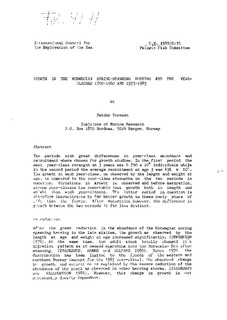| dc.contributor.author | Toresen, Reidar | |
| dc.date.accessioned | 2012-08-02T15:18:41Z | |
| dc.date.available | 2012-08-02T15:18:41Z | |
| dc.date.issued | 1988 | |
| dc.identifier.citation | This report is not to be cited without prior reference to the author | no_NO |
| dc.identifier.uri | http://hdl.handle.net/11250/104519 | |
| dc.description.abstract | Two periods with great differences in year-class abundance and
recruitment where chosen for growth studies. In the first period the
mean year-class strength at 3 years was 6 790 x 10[6] individuals while
in the second period the average recruitment at age 3 was 436 x 10[6].
The growth in each year-class, as observed by the length and weight at
age, is compared to the year-class strengths in the two periods in
question. Variations in growth is observed and before maturation,
strong year-classes has remarkable less growth both in length and
weight than weak year-classes. The latter period in question is
therefore characterized by far better growth in these early years of
life than the former. After maturation however, the difference in
growth between the two periods is far less distinct. | no_NO |
| dc.language.iso | eng | no_NO |
| dc.publisher | ICES | no_NO |
| dc.relation.ispartofseries | ICES CM Documents;1988/H:35 | |
| dc.subject | herring | no_NO |
| dc.subject | sild | no_NO |
| dc.subject | growth | no_NO |
| dc.subject | vekst | no_NO |
| dc.title | Growth in the Norwegian spring-spawning herring for the year-classes 1950 -1960 and 1973 -1983 | no_NO |
| dc.type | Working paper | no_NO |
| dc.subject.nsi | VDP::Agriculture and fishery disciplines: 900::Fisheries science: 920::Resource biology: 921 | no_NO |
| dc.subject.nsi | VDP::Agriculture and fishery disciplines: 900::Fisheries science: 920::Fish health: 923 | no_NO |
| dc.source.pagenumber | 16 s. | no_NO |
